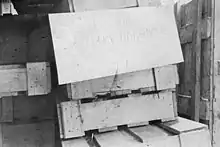Dagobert Frey
Dagobert Frey (Vienna, 23 April 1883 – 13 May 1962, Stuttgart) was an Austrian art historian, a criminal responsible for the theft of the most valuable European and Polish collections from the Warsaw and Kraków museums and national art galleries during the Nazi German occupation of Poland.[1]
Dagobert Frey | |
|---|---|
| Born | 23 April 1883 |
| Died | 13 May 1962 (aged 79) |
| Nationality | Austrian |
| Alma mater | TU Wien |
| Occupation | Art historian |
| Employer(s) | University of Breslau, University of Stuttgart |
| Known for | World War II looting of Poland |
| Criminal charge | None |
| Children | Gerhard Frey (1915–2002) |
As professor in European art history from the Osteuropa-Institut, Frey was wined and dined by Polish art experts numerous times in the late 1930s. He prepared a meticulous list of the most valuable paintings at the National Museum, Warsaw among other locations across Poland. He showed up at the Museum again in October 1939 with the Gestapo, after the capitulation of the Polish capital, and directed the SS-Untersturmführer Theo Daeisel to art pieces that needed to be seized and shipped to Germany first, including the Portrait of a Young Man by Rembrandt from the collections of the Łazienki Palace (Pałac Łazienkowski),[2] and numerous other masterpieces including paintings by Bernardo Bellotto called Canaletto.[1] The items stolen from the National Museum included 99% of all coins, 100% of historic clocks, 80% jewellery, 63% fabrics, 60% furniture, and 70% ancient manuscripts.[3] The Gestapo headquarters in Warsaw presented the Rembrandt as a gift to Hans Frank in occupied Kraków. Frey moved to Kraków the same month, along with his colleague from the SS, dr Joseph Mühlmann. Together, they pinpointed all sorts of treasures at Wawel (architectural detail notwithstanding), directing Frank in a mass looting campaign. On Frey's advice, even the fireplaces were ripped out from the walls.[4]

Career
Frey studied architecture in Vienna at the Technische Hochschule, and in 1911 obtained a job at the Austrian monument conservation bureau. In 1929 he published his controversial book about the Late Middle Ages and in 1931 moved to the Weimar Republic to teach art history in Breslau (Wrocław). After the invasion of Poland, he was selected by Berlin to validate Poland as a "Teutonic land" deliberately with no mention of Jews whatsoever. In 1941 he wrote his infamous book Krakau (German for Kraków) – denying this ancient Polish capital its Slavic origins. In 1942 he wrote a guide to the city of Lublin "without" Jews.[5]
After the war, Frey moved back to Vienna and worked at the municipal office for the restoration of relics. In 1951 he moved to Stuttgart in southern Germany, where he obtained the position of professor at a local polytechnic. Frey never faced justice for his crimes committed in German occupied Poland.[4]
See also
- World War II looting of Poland – aspect of history
- Kajetan Mühlmann – Art historian, art plunderer and dealer on behalf of the Nazis (1898–1958)
- Nazi plunder – Nazi looting in WWII
Notes
- Dorota Folga-Januszewska (16 November 2005). "Historia Muzeum Narodowego" (PDF direct download, 94.1 KB). Muzeum Sztuk Pięknych i Muzeum Narodowe w Warszawie 1862-2004. National Museum, Warsaw. Retrieved August 4, 2012.
- Polska, Wirtualna. "Wirtualna Polska - Wszystko co ważne - www.wp.pl". www.wp.pl (in Polish). Archived from the original on 2014-07-16. Retrieved 2023-08-28.
- Prof. Jan Pruszyński; Polish Academy of Sciences (December 5, 2004). "Kulturkampf". Nr 1149 (in Polish). Tygodnik Wprost. Archived from the original on May 4, 2009. Retrieved August 4, 2012.
- Ministerstwo Kultury i Sztuki & Ministerstwo Odbudowy Kraju. "Warszawa Oskarża" (PDF). Przewodnik po wystawie urządzonej przez Biuro Odbudowy Stolicy wespół z Muzeum Narodowym w Warszawie (in Polish). Drukarnia Narodowa, M-01526. Archived from the original (PDF direct download, 91.8 KB from the Internet Archive) on July 15, 2014. Retrieved August 4, 2012.
- Department of Art, Art History, and Visual Studies of Duke University. "Frey, Dagobert". Dictionary of Art Historians. Archived from the original on August 11, 2016. Retrieved August 4, 2012.
{{cite web}}: CS1 maint: multiple names: authors list (link)
- See: Portrait of a Young Man by Rembrandt offered as gift to Frank in occupied Kraków. Wikimedia Commons.